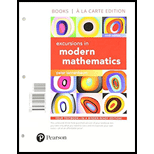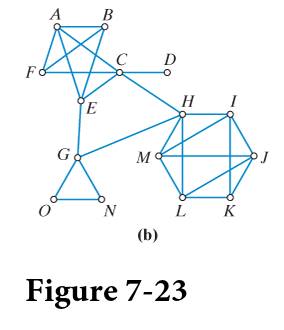
Consider the network shown in.
a. Find two vertices in the network having five degrees of separation between them.
b. If you can, find two vertices in the graph having six degrees of separation between them. If you can’t, then briefly explain why you don’t think there are any.
c. What is the diameter of the network?

Want to see the full answer?
Check out a sample textbook solution
Chapter 7 Solutions
EXCURSIONS IN MOD.MATH W/ACCESS >BI<
- 2) Prove (AB) UC = (AUC)n (BUC).arrow_forward2) Find the maximum value of f(x, y) = x - y on the circle x² + y² - 4x - 2y - 4 = 0.arrow_forwardBlue Ridge Hot Tubs manufactures and sells two models of hot tubs: the Aqua-Spa and the Hydro-Lux. Howie Jones, the owner and manager of the company, needs to decide how many of each type of hot tub to produce during his next production cycle. Howie buys prefabricated fiberglass hot tub shells from a local supplier and adds the pump and tubing to the shells to create his hot tubs. (This supplier has the capacity to deliver as many hot tub shells as Howie needs.) Howie installs the same type of pump into both hot tubs. He will have only 200 pumps available during his next production cycle. From a manufacturing standpoint, the main difference between the two models of hot tubs is the amount of tubing and labor required. Each Aqua-Spa requires 9 hours of labor and 12 feet of tubing. Each Hydro-Lux requires 6 hours of labor and 16 feet of tubing. Howie expects to have 1,566 production labor hours and 2,880 feet of tubing available during the next production cycle. Howie earns a profit of…arrow_forward
- 7. From a point 20 m away on a level ground, the angle of elevation to the bottom of a the top of the window is 32°. Calculate the window is 27° and the angle of elevatim height of the window. (3 marks) 32 SOUCAHTOA Rom Coso-Adj opponite 1270 H X Hyp Tant=OPP Adj 20 # Zom Adjacent CoS2E 20 XHX Tanz 20 20 K -0.0445503261 -1.764201788 0-044550326 60044550320 (1 mark) 3960 8. All odd numbers from 1 to 10 are arranged in descending order to form a number. (i) Write the number. 35798. 97531 31 (ii) Write the total value of the second digit of the number formed in (a) (i) FA 7X1000-7000 이 (1 mark) 9. A cylinder has a diameter of 28 cm and the height is 18 cm. Calculate its volume. 2 22 × 14 × 14 × 18 -110880m 3 (3 marks) 10. The figure below shows a right pyramid with AB = 3 cm, BC = 5 cm, and AV VC = VD = 4 cm. Draw its net. V 3+ 12 7/18 (2/20 2105 SSS 20arrow_forwardNo chatgpt pls will upvotearrow_forwardFind an nfa that accepts the language L(aa (a + b)). Create and test the NFA in Jflap. Test the strings: aab, ab, aaaa, aaaab, baab, aa, abbbb, a, b, 1. Submit the Jflap diagram and the Jflap test cases. 4. Find an nfa that accepts the language L (aa* (a+b)).arrow_forward
- CVE, AVM, AC, ¬SA¬ME A Fitch Style proof for this argumentarrow_forward13:26 ... ← Robert F. Blitzer - Thinkin... 0,04 61 KB/d 目 polygons to create a fraudulent tessellation with discrepancies that are too subtle for the eye to notice. In Exercises 45-46, you will use mathematics, not your eyes, to observe the irregularities. B A 45. Find the sum of the angle measures at vertex A. Then explain why the tessellation is a fake. 46. Find the sum of the angle measures at vertex B. Then explain why the tessellation is a fake. =et at If se Fic SECTION 10.3 Polygons, Perimeter, and Tessellations 645 61. I find it helpful to think of a polygon's perimeter as the length of its boundary. 62. If a polygon is not regular, I can determine the sum of the measures of its angles, but not the measure of any one of its angles. 63. I used floor tiles in the shape of regular pentagons to completely cover my kitchen floor. In Exercises 64-65, write an algebraic expression that represents the perimeter of the figure shown. is be 64. le a b C 2/ If se nyarrow_forwardnot use ai please don'tarrow_forward
- pls helparrow_forwardUse the formulas developed in this section to find the area of the figure. A= (Simplify your answer.) 8.5 m 7 T 13 m 7.7 m m 21 marrow_forwardFind the circumference and area of the circle. Express answers in terms of and then round to the nearest tenth. Find the circumference in terms of C = (Type an exact answer in terms of л.) 9 cmarrow_forward
- Algebra & Trigonometry with Analytic GeometryAlgebraISBN:9781133382119Author:SwokowskiPublisher:Cengage
 College AlgebraAlgebraISBN:9781305115545Author:James Stewart, Lothar Redlin, Saleem WatsonPublisher:Cengage Learning
College AlgebraAlgebraISBN:9781305115545Author:James Stewart, Lothar Redlin, Saleem WatsonPublisher:Cengage Learning

